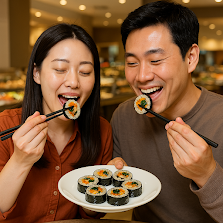Kimbap, the representative soul food of Koreans loved by all ages and genders! From the nostalgic kimbap that mom used to make for picnics, to the convenience store kimbap that you can easily enjoy, to the fusion kimbap that has recently captured the taste buds of the MZ generation, its types and charms are endless.
Today, we will explore the colorful world of kimbap that Koreans love, and tell you everything from delicious kimbap recipes to storage methods and interesting stories related to kimbap.
What is your favorite kimbap?
Let’s fall in love with the charm of kimbap together.
Recently, with the emergence of the MZ generation, diversity in food culture is being respected, and various attempts are being made to reflect their individuality and tastes in kimbap.
In addition to traditional ingredients, luxurious stir-fried meats and soft cheeses are used as fillings, and the ingredients that cover the outside are also expanding to not only kimbap, but also seaweeds such as kelp, fresh lettuce, and leafy vegetables such as romaine.
This shows that kimbap is no longer exclusive to picnics or outings, but is establishing itself as a new and trendy meal in everyday life.
Kimbap is classified as an instant food like hamburgers or sandwiches, and food safety management is important due to the possibility of spoilage and food poisoning concerns, especially from late spring when the temperature rises.
It is important to use fresh ingredients, cook in a sanitary environment, and follow proper storage methods.
According to the dictionary, **Gimbap (Gimbap, Seaweed roll)** is a food made by wrapping rice in seaweed and rolling it into a round shape.
Although its origin is not clearly known, it is considered to be a food that has been a part of the Korean diet for a long time.
Although each region has its own unique kimbap, the basic composition and method of making it are not very different. However, in coastal areas such as Chungmu, Gyeongnam, there is a unique form of kimbap called Chungmu kimbap, which is made by wrapping plain rice in seaweed and eating it with seafood such as kkakdugi and squid as side dishes.
In addition, triangle kimbap, which can be easily enjoyed at convenience stores, is gaining popularity.
Even considering the cost of living, the price of kimbap is relatively cheap, which shows that it is a typical food for the common people.
As franchise kimbap specialty stores that prioritize convenience increase, kimbap has become an even more accessible food.
In the past, as in the lyrics of famous **popular singers (e.g. picnic, kimbap)**, the expression "roll it well, wrap it well" suggests that making kimbap pretty and not bursting was an important skill.
In relation to this, the slang term **"bursting kimbap in the side"** is often used in Korea, which metaphorically refers to a situation where something that was going well suddenly goes wrong due to an unexpected problem.
Kimbap is similar to Vietnamese rice paper rolls in that it is eaten by wrapping various ingredients, and it also has something in common with Japanese maki sushi in that rice and seafood are wrapped in seaweed, but there is a fundamental difference in the filling and taste.
In addition, it is similar to Korean ssam bap in that it is eaten by wrapping various ingredients in leafy vegetables, but there is a difference in the presence of seaweed and rice.
One of the important factors that determine the taste and quality of kimbap is sesame oil.
Sesame oil prevents the rice from drying out quickly, acts as a lubricant to prevent the ingredients from sticking together, and also has the effect of slowing down spoilage.
In particular, when cutting kimbap with a knife, the rice grains do not fall apart and are cut cleanly thanks to sesame oil.
Recently, kimbap has become so popular that you can find it even at hotel buffets, and in overseas markets such as the US and Europe, frozen kimbap has been introduced as a nutritious diet food, gaining great popularity as a Korean food.
Now, kimbap has become another representative Korean food along with kimchi, bulgogi, and bibimbap.
In addition to the basic ingredients such as carrots, burdock, fish cake, and crab meat, various ingredients are used, and because of the complicated cooking process, it is also released in the form of a kimbap kit so that you can easily make it at home.
In addition, modified forms such as fried tofu kimbap using fried tofu instead of seaweed and nude kimbap with rice on the outside are also popular.
Kimbap is a representative combination that boasts a fantastic compatibility with various snack menus such as ramen, tteokbokki, jjolmyeon, and kim tteoksun, and is enjoyed together.
<Nude Kimbap>
Today, we talked about various stories about kimbap, the eternal soul food of Koreans.
The charm of kimbap, which contains memories and culture beyond a simple meal, seems truly endless.
Which kimbap do you want to eat the most today?
Let us know your favorite kimbap in the comments!



.jfif)













.jfif)














